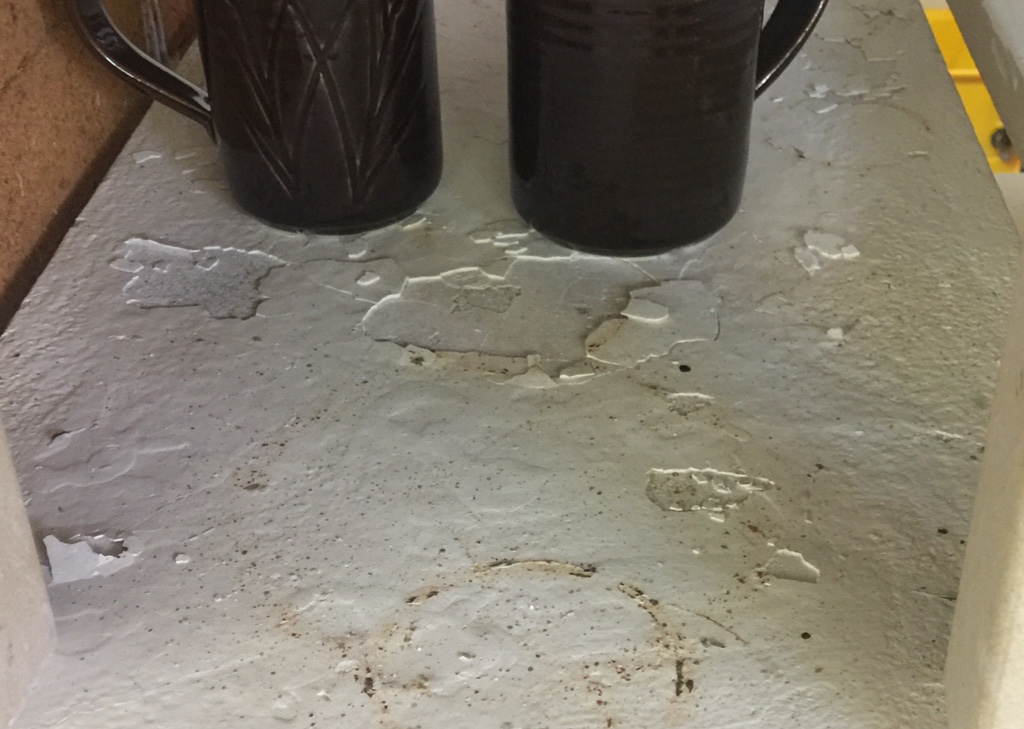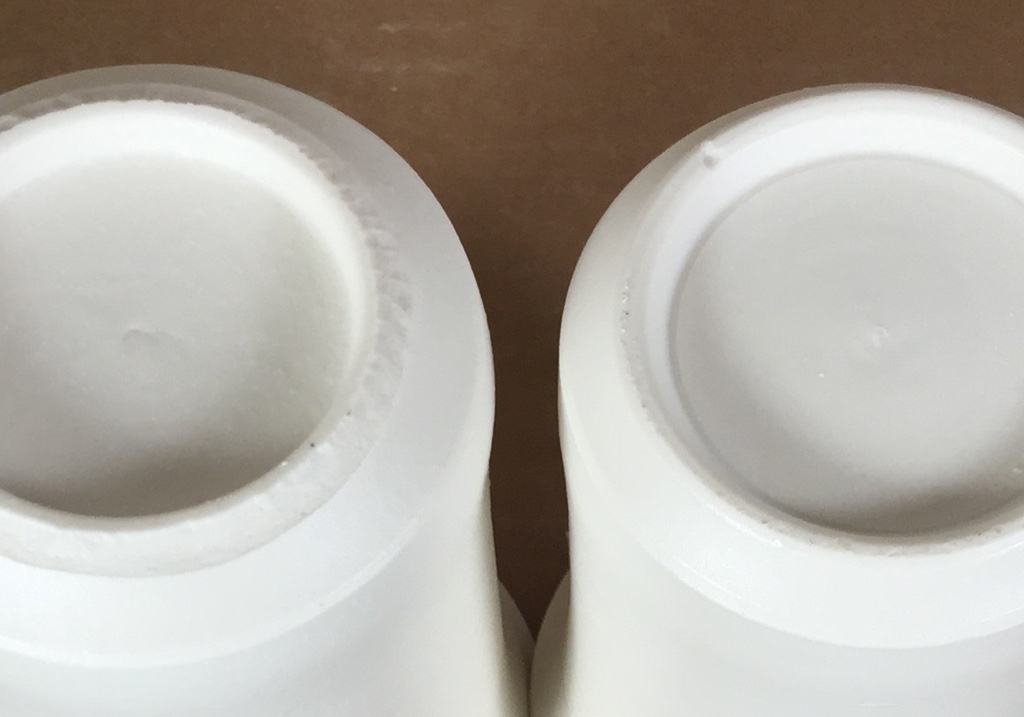| Monthly Tech-Tip | No tracking! No ads! | |
Kiln Wash
A high-melting powder applied to kiln shelves to prevent ware from sticking to the shelf during firing. It is also used as a parting agent for to keep elements of fired ware from sticking to each other.
Key phrases linking here: kiln wash - Learn more
Details
A refractory powder that can be mixed with water (and gum solution) and painted on kiln shelves to prevent ware and accidental glaze drips from sticking. Porcelain clays, for example, melt enough during firing that they tend to stick onto the kiln shelf. But with a good wash there are no problems. Certain clays contain soluble salts which fire to a glaze-like sheen, these also tend to stick ware to shelves.
When a shelf is properly protected by kiln wash, pure molten glaze can run onto it during firing and simply be lifted off when the kiln is unloaded. If the kiln wash works really well, lifting it off will only take upper layers of the refractory wash powder, leaving some still on the shelf. Wash should be reapplied to areas when it has flaked off or is getting thin. It is thus important for the kiln wash powder to be as refractory as possible. Non-refractory washes harden into flakes that stick to the bottoms of ware. A very high percentage of calcined alumina is theoretically best. Even better, zircon (these powders are very fine, they create a good slurry).
Common recipes contain high percentages of kaolin (50:50 kaolin:silica is common). This percentage is creating a clay-body-like material (also having plenty of drying shrinkage). A small amount of feldspar can be found in some recipes. This is strange, perhaps it is used to de-powder the fired layer. Sometimes kiln washes are deflocculated. This is also not necessary, it makes a brushing wash that already dries much too fast dry even faster.
Application to refractory shelves and furniture is generally done by painting. If using the 50:50 kaolin:silica recipe it is best to minimize water so it stays in suspension (we have found good results using 50:50 water:powder). Given the above-mentioned materials, a simple slurry of water and powder will create a white-wash style slurry that will dry on-contact to porous refractory surfaces, that can make it difficult to achieve an even-thickness and smooth application. One solution is to employ CMC Gum in a manner similar to making brushing glazes. The gum will slow drying speed, making it flow and apply like a paint. The gum will also prevent cracking during drying, enabling lay-down of multiple layers if needed. Additionally, the gum makes it possible to minimize raw clay content, reducing shrinkage (e.g. switching some of the raw kaolin in the mix to flat-particled calcined kaolin).
Good quality kiln wash can be used to line crucibles so that molten materials will shed off or can be removed as an ingot after the kiln cools.
Related Information
Flaking kiln wash on a silicon carbide kiln shelf

This picture has its own page with more detail, click here to see it.
This is a 50:50 kaolin:silica wash. While economical, this is not an ideal recipe. It gets too hard and shrinks too much during drying and firing. It is better to use a recipe that remains somewhat powdery to the touch. Pure calcined alumina with a little calcined kaolin (about 10%) gives almost zero shrinkage. Add more kaolin if it fires too powdery or less if fires too hard. Add 1% CMC gum to produce a very paintable material (it will take some time to dry).
A running glaze has stuck to a kiln shelf. Kiln wash saves the day!

This picture has its own page with more detail, click here to see it.
This is a zircon-based kiln wash. Even though it paints on in a thin layer, there is no problem releasing the very runny glaze from the shelf.
Kiln wash that really works. How?

This picture has its own page with more detail, click here to see it.
The shelf on the right has the traditional kaolin:silica kiln wash. Flaking constantly. Sticking to the feet of ware (plucking). A real aggravation. The one on the left is L4001, it is perfectly even. Yet thin. Much more refractory so it has not become brittle. Or cracked. And it paints on beautifully. The secret is four-fold? First: Zircopax (or Zircon) is among the most refractory materials used in ceramics. Second: We mixed it with calcined, rather than raw kaolin. That greatly reduces drying and firing shrinkage. Third: The zircon makes up 80% of the recipe, not 50%. Fourth: CMC gum (via Laguna gum solution) takes on the role of hardener. But it does much more: It also slows down the drying and gives the slurry the consistency of paint (for each application by brush or roller). Click the link below to get the recipe.
The foot ring on the left is plucking, the right one is not. Why?

This picture has its own page with more detail, click here to see it.
These are translucent porcelains, they are vitreous. The firing is to cone 10. The one on the left is a cone 6 body, and, while it survives to cone 10 it does warp. But more important, it is much more vitreous (more melted). The plucking problem makes it quite difficult to get a good foot ring. The other, which has only slight plucking, is also quite vitreous (high in feldspar). The plucking problem on both can be solved by simply using a better kiln wash. What is better? More refractory, and therefore having a powdery, non-stick surface. Spend more money on your kiln wash, base it on calcined alumina or zircon.
Even with good kiln wash plucking can sometimes occur

This picture has its own page with more detail, click here to see it.
These were left by ware made from a cone 6 highly vitreous translucent porcelain. For that type of clay it would be advisable to set ware on a thin layer of silica sand or granular alumina.
Links
| Glossary |
Water Solubility
The water solubility of ceramic materials is an important consideration to their usability in the process. Glazes are suspensions of insert powders, solubles present problems to this system. |
| Glossary |
Plucking
A firing issue in ceramics where the foot rings of vitreous ware stick to the kiln shelf. Removing them leaves sharp fragments glued to the shelf. |
| URLs |
https://insight-live.com/insight/share.php?z=DDBJSBWmiM
Refractory Alumina body, Zircon Kiln wash recipes |
| URLs |
https://insight-live.com/insight/share.php?z=K5hHzDs2Kr
Plainsman Super Kiln Wash recipe Instead of 50:50 kaolin:silica this recipe uses 80:20 Zircopax:Calcined kaolin. And adds CMC gum to slow down drying, make it brushable, harden it and reduce water requirements. |
| By Tony Hansen Follow me on        |  |
Got a Question?
Buy me a coffee and we can talk

https://digitalfire.com, All Rights Reserved
Privacy Policy
